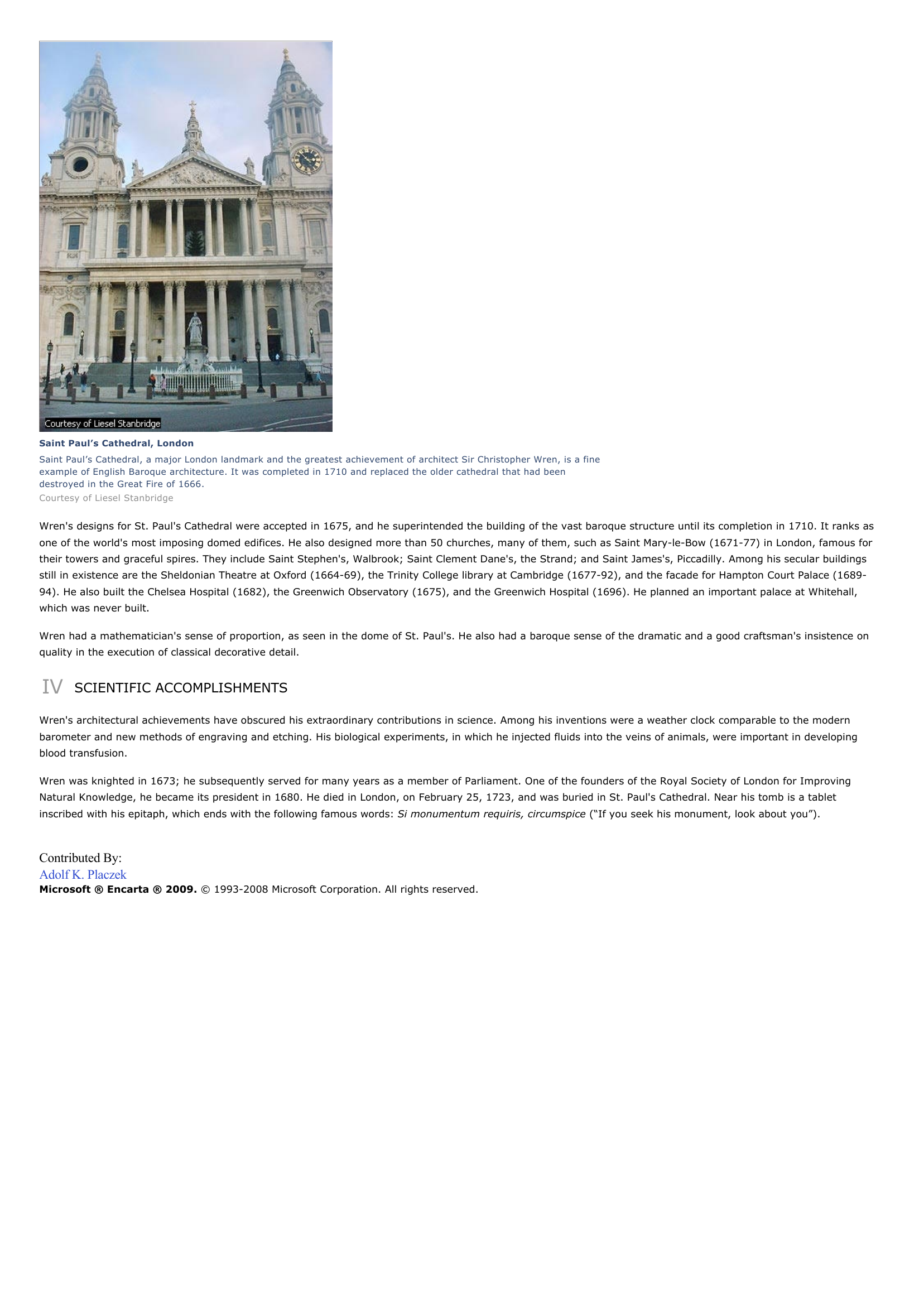Sir Christopher Wren I INTRODUCTION Sir Christopher Wren (1632-1723), English architect, scientist, and mathematician, who is considered his country's foremost architect.
Publié le 12/05/2013

Extrait du document
«
Saint Paul’s Cathedral, LondonSaint Paul’s Cathedral, a major London landmark and the greatest achievement of architect Sir Christopher Wren, is a fineexample of English Baroque architecture.
It was completed in 1710 and replaced the older cathedral that had beendestroyed in the Great Fire of 1666.Courtesy of Liesel Stanbridge
Wren's designs for St.
Paul's Cathedral were accepted in 1675, and he superintended the building of the vast baroque structure until its completion in 1710.
It ranks asone of the world's most imposing domed edifices.
He also designed more than 50 churches, many of them, such as Saint Mary-le-Bow (1671-77) in London, famous fortheir towers and graceful spires.
They include Saint Stephen's, Walbrook; Saint Clement Dane's, the Strand; and Saint James's, Piccadilly.
Among his secular buildingsstill in existence are the Sheldonian Theatre at Oxford (1664-69), the Trinity College library at Cambridge (1677-92), and the facade for Hampton Court Palace (1689-94).
He also built the Chelsea Hospital (1682), the Greenwich Observatory (1675), and the Greenwich Hospital (1696).
He planned an important palace at Whitehall,which was never built.
Wren had a mathematician's sense of proportion, as seen in the dome of St.
Paul's.
He also had a baroque sense of the dramatic and a good craftsman's insistence onquality in the execution of classical decorative detail.
IV SCIENTIFIC ACCOMPLISHMENTS
Wren's architectural achievements have obscured his extraordinary contributions in science.
Among his inventions were a weather clock comparable to the modernbarometer and new methods of engraving and etching.
His biological experiments, in which he injected fluids into the veins of animals, were important in developingblood transfusion.
Wren was knighted in 1673; he subsequently served for many years as a member of Parliament.
One of the founders of the Royal Society of London for ImprovingNatural Knowledge, he became its president in 1680.
He died in London, on February 25, 1723, and was buried in St.
Paul's Cathedral.
Near his tomb is a tabletinscribed with his epitaph, which ends with the following famous words: Si monumentum requiris, circumspice (“If you seek his monument, look about you”).
Contributed By:Adolf K.
PlaczekMicrosoft ® Encarta ® 2009. © 1993-2008 Microsoft Corporation.
All rights reserved..
»
↓↓↓ APERÇU DU DOCUMENT ↓↓↓
Liens utiles
- Wren (sir Christopher), 1632-1723, né à East Knoyle (Wiltshire), mathématicien, astronome et architecte anglais.
- William Blake I INTRODUCTION William Blake (1757-1827), English poet, painter, and engraver, who created an unusual form of illustrated verse; his poetry, inspired by mystical vision, is among the most original, lyric, and prophetic in the language.
- Galileo I INTRODUCTION Galileo (1564-1642), Italian physicist and astronomer who, with German astronomer Johannes Kepler, initiated the scientific revolution that flowered in the work of English physicist Sir Isaac Newton.
- Isaac NewtonIINTRODUCTIONIsaac Newton (1642-1727), English physicist, mathematician, and natural philosopher, considered one of the most important scientists of all time.
- William Shakespeare I INTRODUCTION William Shakespeare English playwright and poet William Shakespeare, who lived in the late 1500s and early 1600s, is regarded as the greatest dramatist in the history of English literature.

































